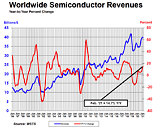CHIPS Act Requirements Untenable According to Silicon Manufacturers in South Korea and Taiwan
Silicon manufacturers in South Korea and Taiwan have questioned the requirements outlined in the United States Chips and Science Act - South Korean President Yoon Suk Yeol spoke on Thursday March 30, and said that there was a growing concern within companies Samsung Electronics Corporation and SK Hynix Inc. with regard to criteria for new U.S. semiconductor subsidies. Excess profit sharing is one area of contention, as the U.S. government will expect dividends to be paid under special conditions. The companies are also reluctant to meet the requirements of submitting detailed information about fab capacity and yield estimates. Leaders are pointing to the potential sensitive nature of exposing too much confidential corporate strategy to bodies in the USA, and sources within Samsung and SK Hynix are worried that budgetary planning information will be revealed in minute detail.
The CHIPS Act grants a $52 billion pool of research and manufacturing funds, and subsidies would be sourced from it. SK Hynix's parent group is considering an application in order to gain access to funding via the CHIPS Act, the SK Group has formed plans to invest $15 billion of its own money into the U.S. chip manufacturing sector - a North American location for an advanced chip packaging plant is being decided upon. Samsung has invested a substantial $25 billion into its Texas operation, so is eligible to receive U.S. government subsidies as well.
The CHIPS Act grants a $52 billion pool of research and manufacturing funds, and subsidies would be sourced from it. SK Hynix's parent group is considering an application in order to gain access to funding via the CHIPS Act, the SK Group has formed plans to invest $15 billion of its own money into the U.S. chip manufacturing sector - a North American location for an advanced chip packaging plant is being decided upon. Samsung has invested a substantial $25 billion into its Texas operation, so is eligible to receive U.S. government subsidies as well.






































